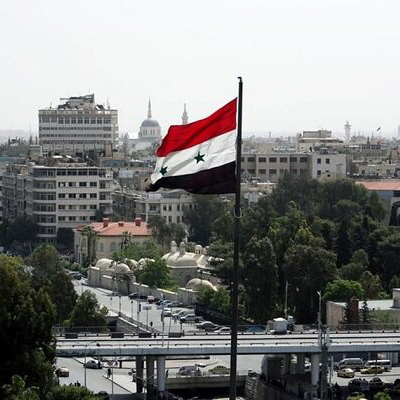Sites
Syria
Written by: Emad Ezatabadi,
Translated by: Hadi Qorbanyar
66 Views
The Syrian Arab Republic was one of Iran’s main supporters during the Iran–Iraq War, both military and diplomatically. With a population of more than 25 million across an area of 185,180 square kilometers, it is a country in West Asia located in the Eastern Mediterranean. Damascus is the capital of Syria. It borders the Mediterranean Sea and Lebanon to the west, Turkey to the north, Jordan and the Zionist Regime to the south, and Iraq to the east.
Part of this region was conquered by Muslims in 635, and following the Battle of Yarmouk in 636, the entire Syria came under Muslim rule. Syria was part of the Ottoman Empire until the conclusion of World War I. Following the empire’s collapse after the war, two distinct authorities emerged: a French-backed administration in the coastal areas and an Arab government led by Emir Faisal in the inland regions.[1] Syria gained independence in September 1941, and in August 1943 held its first presidential election, in which Shukri al-Quwwatli was elected president.
On June 5, 1967, Israel attacked Syria and occupied the city of Quneitra, located about 40 miles south of Damascus, as well as the Golan Heights.[2] On November 16, 1970, Hafez al-Assad came to power through a bloodless coup against the government of Salah Jadid.[3] In October 1973, Syria and Egypt initiated an attack against the Zionist Regime to reclaim the territories lost in the 1967 war. Although Egypt later signed a peace agreement with Israel, Syria succeeded in recapturing the city of Quneitra.[4]
After the victory of the Islamic Revolution in Iran, Hafez al-Assad congratulated the Iranian leadership and declared his country’s support for the Revolution.[5] Syria and Libya were the only Arab states to express support for Iran at the Arab League summit in Jeddah shortly before the Iran–Iraq War. Most other Arab countries backed Iraq.[6]
When the war began, Syria initially adopted a cautious stance, uncertain about the outcome, and remained silent for the first two weeks. In the meantime, Assad contacted Jordan and Saudi Arabia to seek ways to end the conflict. However, after two weeks, Syria officially condemned the Iraq’s invasion of Iran.[7] About six weeks into the war, Assad made his first clear and public statement during a graduation ceremony for paratroopers, emphasizing that the war was “a conspiracy by the Baghdad regime against all Arabs”.[8]
This firm position led to the severing of diplomatic relations between Iraq and Syria on October 12, 1980. Subsequently, Syria halted the transit of Iraqi oil through its territory and closed all its borders with Iraq. In addition, it signed an agreement with Iran to import oil. The decision significantly undermined Iraq’s war economy, depriving it of nearly half its oil-based revenue. Diplomatically, Syria’s efforts were crucial in preventing the Iran–Iraq War from turning into a broader Arab–Iranian conflict, thereby ensuring that Iran was not isolated in the region. At the same time, by supporting Iraqi opposition groups, Damascus helped open a second front inside Iraq, forcing part of Saddam’s military forces to focus on suppressing internal dissent rather than fighting Iran.[9]
On October 8, 1980, Hafez al-Assad traveled to Moscow to sign the Treaty of Friendship and Cooperation. In a joint statement, Assad and Soviet leader Leonid Brezhnev condemned Iraq. The Soviet Union also agreed to provide military aid to Syria and allow Soviet-made weapons to be sent to Iran. From that point on, Syria became one of the key routes for supplying Iran with military equipment. Soviet arms also reached Iran through other countries such as Libya and Algeria. Furthermore, the Syrian government shared intelligence with Iran, including information on Iraq’s military plans and capabilities.[10] One clear example of this cooperation was Iran’s air attack on Iraq’s Al-Walid air bases. On April 4, 1981, Iran launched the operation in which Syria played a key role.[11] Refueling was carried out in Syrian airspace before the attack on the H-3 bases, and after the mission, a damaged Iranian Phantom jet landed at a Syrian airfield.[12]
When Israel invaded southern Lebanon in June 1982, Iran deployed forces to Lebanon and Syria to support the Lebanese people. However, given Iran’s priority to counter Iraq’s aggression, its troops soon were pulled back. Later, as Iranian ground forces entered Iraqi territory and fighting continued through 1984, Syrian officials again voiced support for Iran. They did not view Iran’s advance into Iraq as a threat to the Persian Gulf states, but rather as a direct challenge to Saddam’s regime.[13]
In August 1984, a 25-member delegation from the Islamic Revolutionary Guard Corps (IRGC) Ministry visited Syria and Libya.[14] A few months later, a 15-member IRGC team went to Syria to receive training in the use of Scud missiles. This led to the establishment of the IRGC’s missile unit. Between Iran’s capture of Al-Faw and its acceptance of UN Resolution 598, Syria maintained a stance of cautious criticism and mediation efforts. Despite strong economic and political incentives, including offers of oil and financial aid, as well as pressure from Jordan, Saudi Arabia, and the Soviet Union, Syria refused to join the pro-Iraq camp. This was not an easy decision for the Syrian government. On the one hand, Iran’s push into Iraqi territory made it difficult for Damascus to justify Tehran’s actions to other Arab states, most of which feared Iraq’s collapse. On the other hand, Lebanon was in the midst of a civil conflict between Hezbollah—backed by Iran—and the Amal Movement, supported by Syria, whose influence had diminished in the face of Hezbollah’s growing power. These developments strained relations between Tehran and Damascus. Nevertheless, Assad’s government welcomed Iran’s success in Al-Faw, despite facing a wave of hostile propaganda. Syria continued to view Zionism and Western imperialism as the true enemies in the region and opposed any attempt to provoke confrontation between Arabs and Iranians or to divert Arab attention away from Israel.[15]
Before leaving for the 1986 Kuwait summit, Hafez al-Assad publicly stated that Iran had no plans to invade Iraq or expand its territory.[16] In 1987, during the Amman summit, several Arab states tried to persuade Syria to distance itself from Iran, but their efforts failed.[17] Throughout the war, Syria sought to mediate between Iran, Iraq, and the pro-Iraq Arab states.[18]
After Iran accepted UN Resolution 598 on July 18, 1988, Hafez al-Assad welcomed the decision, describing it as a wise move that would help promote stability and peace in the region.[19]
After the Iran–Iraq War, Syria developed comprehensive and strong political relations with Iran.[20] Following the death of Hafez al-Assad on June 10, 2000, his son Bashar al-Assad assumed power.[21] Unlike his father, who maintained a dominant stance toward Hezbollah in Lebanon, Bashar treated the group as a partner and a governing entity. This, along with changes in Syria’s leadership circle, further strengthened Iran–Syria relations. Although Bashar initially leaned toward Saudi Arabia, the September 11, 2001, attacks in the United States and the assassination of Lebanese Prime Minister Rafic Hariri on January 14, 2005, combined with Washington’s increasingly aggressive policy, brought Syria even closer to Iran.[22]
Beginning in February 2011, amid the wave of the “Arab Spring” movement across North Africa, protests broke out in Syria. Although they were initially peaceful, they gradually turned violent and escalated into a battleground between Bashar al-Assad’s government and opposition groups.
This situation created an opening that allowed ISIS—an organization fostered by the United States—to exploit the power vacuum along Syria’s borders and enter the country.[23] The roots of ISIS can be traced back to al-Qaeda in Iraq, an organization ideologically inspired by the extremist views of Abu Musab al-Zarqawi, who was killed by U.S. forces and Iraqi intelligence in 2006. After Zarqawi’s death, Abu Ayyub al-Masri took over leadership of al-Qaeda in Iraq, and following his death, Abu Bakr al-Baghdadi assumed command in 2010. In 2013, al-Baghdadi formally established the group known as ISIS. In an audio message, ISIS and Jabhat al-Nusra, another terrorist faction in Syria led by Abu Muhammad al-Julani, publicly declared themselves as branches of al-Qaeda.[24]
Viewing Syria as a cornerstone of its regional strategy, Iran intervened to safeguard the achievements of the Islamic Revolution, prevent the spread of war, and keep extremist groups from advancing toward its borders. Syria was considered a key strategic ally and defensive shield for Iran in West Asia.[25] Iran’s Quds Force, under the command of Major General Qassem Soleimani (martyred), launched extensive operations against ISIS in Syria. Ultimately, on November 21, 2017, ISIS was effectively dismantled as a governing and territorial force in the region.[26]
[1] Saeedi, Ebrahim, Suriye (Syria), Tehran: Vezarat-e Omur-e Kharejeh, 1374, Pp. 1, 97–98.
[2] Ibid., Pp. 100, 118.
[3] Ibid., p. 100.
[4] Ibid., Pp. 118–119.
[5] Ibid., p. 137.
[6] Darvishi, Farhad, Jang-e Iran va Araq – Porsesh-ha va Pasokh-ha (The Iran–Iraq War: Questions and Answers), Tehran: Markaz-e Motaleat va Tahqiqat-e Jang-e Sepah-e Pasdaran, 1st ed., 1386, p. 179.
[7] Soltani-Nejad, Ahmad, Siasat-e Khareji-ye Suriye dar Jang-e Iran va Araq 1359–1367 (Syria’s Foreign Policy during the Iran–Iraq War, 1980–1988), Tehran: Safhe-ye Jadid, 1392, Pp. 154–155.
[8] Saeedi, Ebrahim, Ibid., p. 140.
[9] Soltani-Nejad, Ahmad, Ibid., Pp. 158–162.
[10] Ibid., p. 162.
[11] Mehrnia, Ahmad, Haml-e Havaei be al-Walid (H-3) (The Airstrike on al-Walid (H-3)), Tehran: Sooreh Mehr, 1st ed., 1389, Pp. 78, 88.
[12] Ibid., Pp. 166–168.
[13] Soltani-Nejad, Ahmad, Ibid., Pp. 166–168.
[14] Ghafar-Haddadi, Faezeh, Khat-e Muqaddam-e Mobarezeh: Revayat-e Dastani va Mostanad az Tashkil-e Yegan-e Mooshaki dar Iran ba Mehvariyat-e Zendegi-ye Hassan Tehrani-Muqaddam (The Frontline of Struggle: A Narrative and Documentary Account of Iran’s Missile Unit Formation Based on the Life of Hassan Tehrani-Muqaddam), Qom: Manzoome-ye Shamsi, 1394, Pp. 26, 43.
[15] Soltani-Nejad, Ahmad, Ibid., Pp. 174–178.
[16] Ibid., p. 180.
[17] Ibid., p. 183.
[18] Ibid., p. 188.
[19] Saeedi, Ebrahim, Ibid., p. 141.
[20] Norouzi-Fard, Ali-Reza va Digaran, Barrasi-ye Aayande-ye Ravabet-e Iran va Suriye va Tasir-e Aan bar Jeopolitik-e Mantaqei (Assessing the Future of Iran–Syria Relations and Its Impact on Regional Geopolitics), Faslname-ye Aamayesh-e Siasi-ye Faza, Vol. 3, No. 1, Zemestan 1399, p. 49.
[21] Qorbanzadeh-Savar, Qorbanali va Digaran, Senario-haye Fararuyi-ye Bohran-e Jeopolitik-e Suriye (Emerging Scenarios of the Syrian Geopolitical Crisis), Faslname-ye Mohit-e Rahbordi, Vol. 4, No. 13, Zemestan 1399, Pp. 166–167.
[22] Darvishi Se-Talani, Farhad, Kankashi dar Ravabet-e Tarikhi-ye Iran va Suriye (1946–2011) (A Study of the Historical Relations between Iran and Syria, 1946–2011), Tarikh-Name-ye Vol. 1, No. 1, Bahar–Tabestan 1396, Pp. 136–137.
[23] Ehrami, Sajjad va Digaran, Bohran-e Suriye, Mianjigari-ye Beyn-ol-Melali va Jaygah-e Jomhuri-ye Eslami dar Hall-e Aan (The Syrian Crisis, International Mediation, and the Role of the Islamic Republic in Its Resolution), Faslname-ye Elmi-ye Rahyaft-e Enqelab-e Eslami, Vol. 15, No. 54, Bahar 1400, p. 187.
[24] Hatami, Muhammad-Reza, Sheklgiri-ye Daesh dar Kanoon-e Puyesh-e Jahanishodan (The Formation of ISIS at the Core of Globalization Dynamics), Pazhohesh-Name-ye Ravabet-e Beyn-ol-Melal, Tabestan 1394, No. 30, Pp. 154–155.
[25] Sadeqi, Seyyed Shamsuddin va Digaran, Tahlil-e Mavaze-e Jomhuri-ye Eslami-ye Iran dar Qebal-e Bohran-e Suriye (An Analysis of the Islamic Republic of Iran’s Stance on the Syrian Crisis), Nashriye-ye Jostar-haye Siasi-ye Moaser, Vol. 6, No. 1, Bahar 1394, p. 140.
[26] Aminabadi, Seyyed Muhammad, Payan-e Khelafat-e Sheytani-ye Daesh / Vaade-ye Sadeq-e Sardar Cheguneh Mohaqqaq Shod? (The End of ISIS’s Satanic Caliphate: How the Commander’s Truthful Promise Was Fulfilled?), Roozname-ye Keyhan, Darichei be Jahan, Panjshanbe, 9 Azar 1396, No. 21781.





